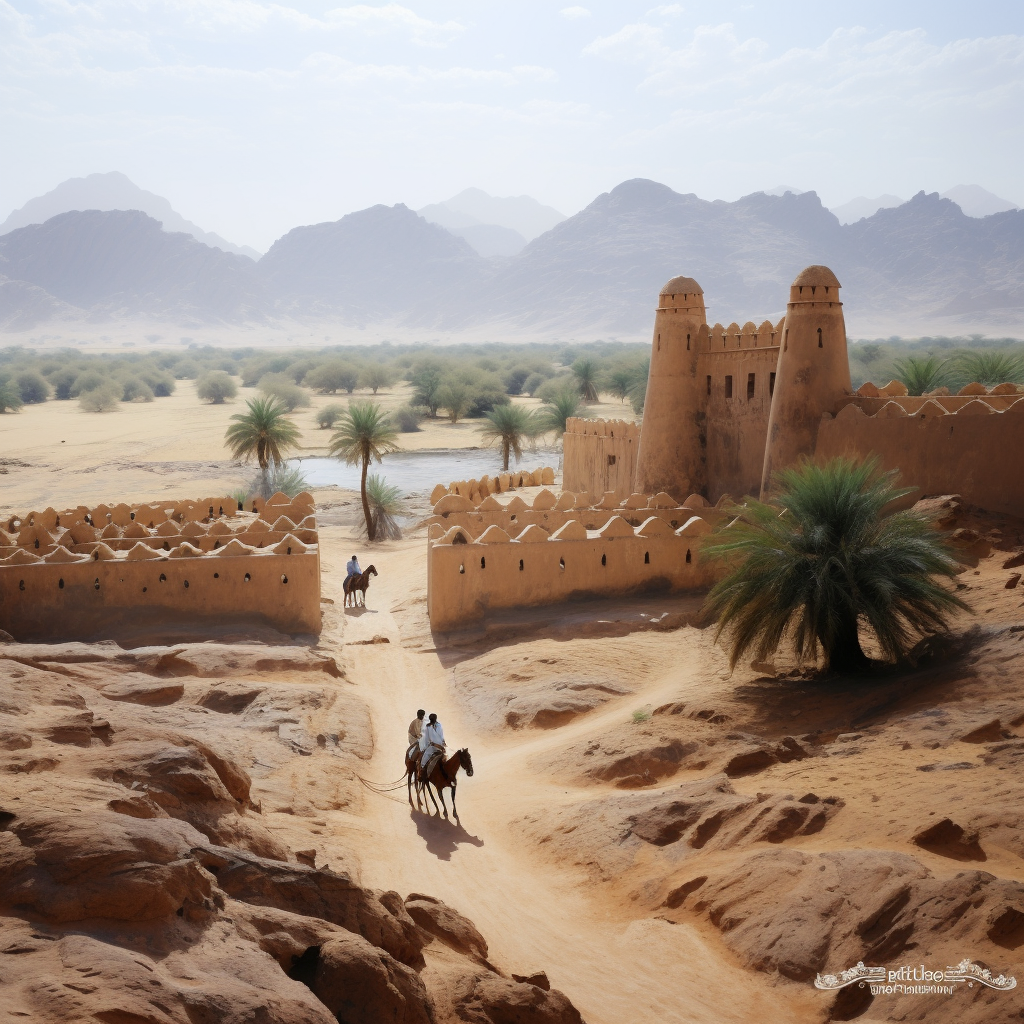D.G. Hogarth, a distinguished 19th-century British archaeologist renowned primarily for his works on ancient Greek sites, authored a significant book titled “The Penetration of Arabia.” This constituted arguably the first significant attempt to gather the accumulated knowledge of European travellers to the Arabian peninsula together in a single piece of literature, offering a comprehensive overview of the Arabian peninsula and it’s diverse regions. As we embark on this essay, we will delve into the endeavours of early 19th-century travellers to Oman, chronicled by Hogarth, such as James Wellsted and Carsten Niebuhr. These explorers, though distinct in their experiences, collectively contributed to unravelling the mysteries of Oman’s uncharted territories, enriching our understanding of its diverse landscapes and historical tapestry.
Geographical Background
In the 19th century, while the central part of Oman was relatively well-known to early cartographers, the southern areas remained largely uncharted, constituting a significant portion of the Arabian Peninsula. It was within this unexplored terrain that explorers, whose tales were masterfully recounted by D.G. Hogarth, sought to unravel the geographical mysteries. The western end, occupying the interval between the twenty-seventh and thirteenth parallels, became a focal point for these early adventurers. Hogarth, through his writings, played a crucial role in bringing to light the uncharted expanses of southern Oman, providing readers with a vivid portrayal of the geographical wonders and challenges encountered by the explorers of his time.
Known Territories
While some territories in the Arabian Peninsula, such as Hadramaut and Oman, were recognized for their settled communities and renowned spice trade, the precise knowledge of these regions remained incomplete. The coasts of these territories, despite their significance, lingered in an imperfect understanding, with gaps in cartographic knowledge hindering a comprehensive view. The introduction of Ottoman- Egyptian occupation in 1811, however, brought a measure of clarity to the maps, creating a belt of comparatively well-known territory across the central expanse of Arabian maps. This strategic occupation marked a turning point in the exploration of the Arabian Peninsula, setting the stage for further investigations into both familiar and uncharted lands by intrepid explorers, whose stories would later be meticulously chronicled by authors like D.G. Hogarth.
Historical Exploration
The exploration of Oman traces its roots back to the historical interactions with European powers. Up until the middle of the seventeenth century, both Portuguese and Dutch had interacted with Oman as it was strategically positioned on the maritime route to India. However, it wasn’t until Carsten Niebuhr’s visit in 1765 that a European traveller offered limited insights into the interior of this intriguing land. Niebuhr’s observations, though valuable, only scratched the surface of the vast and varied landscapes that Oman harboured.
Certain parts of Oman had been in western hands, as we have seen, up to the middle of the seventeenth century without our knowledge of the land being sensibly improved. Shortly after the Portuguese evacuation, the Dutchman, Struys, called at Maskat, and found it a flourishing town, of which he has left an interesting drawing; but for a century after his day Oman seems to have remained unvisited by Europeans.
D.G. Hogarth ‘The Penetration of Arabia‘
As the 19th century unfolded, the British East India company’s naval expeditions embarked on a mission against pirates operating from the Persian gulf, unveiling glimpses of Oman’s coastal regions. Though primarily aimed at addressing issues of piracy, these expeditions inadvertently provided valuable insights into the geographical features and challenges present in Oman. The early interactions between Oman and European powers set the stage for more comprehensive explorations, with each expedition contributing to the mosaic of knowledge that would later be meticulously compiled by historians and chroniclers like D.G. Hogarth.
James Wellsted’s Oman Exploration (1835)
In 1835, James Wellsted, a naval lieutenant with a background in surveying, undertook a noteworthy exploration of Oman, facilitated by the permission of the Imam. His expedition commenced with an exploration of the southwestern coast, an area characterised by its lean and featureless landscape on the fringe of the central southern desert. Here, Wellsted encountered Bedawins and the Abu Ali tribes, known for their affiliation with Wahhabism.
Wellsted’s journey continued as he reached Nizwa, a significant stronghold of Oman, and ventured into the surrounding hill country. During this exploration, he made a remarkable discovery of oases that showcased advanced water management systems. The method of obtaining water, with shafts sunk to considerable depths and channels conveying water over several miles, impressed Wellsted, who likened it to Chinese engineering methods.
The inhabitants (Beni Riyam) were few, pagan, and independent. Indeed, everywhere in the interior of Oman, Wellsted found the Imam to exercise a purely nominal suzerainty, and to command neither money nor men.
D.G. Hogarth ‘The Penetration of Arabia’
The intrepid explorer further delved into the heart of Oman, exploring Jabal Akhdar, the central mountain range. His meticulous observations provided insights into the geography and inhabitants of this region. Wellsted documented the ridges as bare and chill, while the valleys boasted fertile grounds, well-planted with vineyards and almond trees.
Urban settlements along the way caught Wellsted’s attention, displaying distinct architectural features. In Ibra, houses were loftily constructed with turreted parapets, Saracenic arches, and ornate stucco decorations. The Batina coast, known for its agriculture and exports, particularly indigo, sugar, and dates, left a lasting impression on the explorer.

However, Wellsted’s expedition was not without challenges. The Wahabi tribes, which had embraced Wahhabism, posed obstacles as he attempted to penetrate deeper into the northern territory. Despite facing the difficulties posed by these tribes, Wellsted persevered until he reached Ibri, approximately fifty miles from the frontier settlement of Bireima. The encounter with Wahabis eventually led to his decision to return to Muscat, concluding the first scientific exploration of Oman in 1835.
Wellsted’s Exploration & Legacy
James Wellsted’s 1835 exploration of Oman left an enduring legacy, significantly enriching our understanding of the country’s interior. His meticulous documentation, including maps and notes, has proven to be a valuable resource, standing the test of time. Wellsted’s insights, gained through his firsthand experiences, offered a comprehensive view of Oman’s geographical features, settlements, and the challenges faced by early explorers.
Publication & Disaster
His expedition uncovered previously unexplored areas, and Wellsted, eager to share his experiences, published an early account of the journey in the Journal of the Royal Geographical Society. Returning to Oman the following winter, Wellsted faced a tragic turn of events, succumbing to fever. In a distressing episode of delirium, he inflicted wounds upon himself, and after being transported to Bombay, he eventually returned to London on leave. Retiring from service in 1839, he spent part of his time in a mental health facility for gentlemen, sustained by his navy pension. Wellsted passed away in 1842 at his family’s residence in London.
Recognition
The significance of Wellsted’s contributions extended beyond his explorations. His papers, presented at the Royal Geographical Society, earned him immediate recognition in the scientific community. His distinction was further affirmed by his election as a fellow of the Royal Society on April 6, 1837, and his membership in the Astronomical Society. His accounts detailing the geography and culture of Oman, provided a unique snapshot of the region at that early date.
In the years that followed, subsequent explorers retraced some of Wellsted’s footsteps, validating and expanding upon his findings. However, despite their efforts, none surpassed the depth and breadth of Wellsted’s contributions. His work remains a foundational pillar in the exploration of Oman, a testament to the pioneering spirit that characterised 19th-century explorers and the lasting impact of their endeavours on our understanding of the world.

